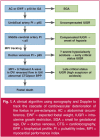Pre-eclampsia and the foetus: a cardiovascular perspective
- PMID: 31199427
- PMCID: PMC9048241
- DOI: 10.5830/CVJA-2017-039
Pre-eclampsia and the foetus: a cardiovascular perspective
Abstract
Pre-eclampsia is the leading cause of perinatal morbidity and mortality. A full understanding of the pathogenesis of this enigmatic condition is essential if we are to develop new prophylactic and therapeutic interventions. Central to our understanding of the pathogenesis of early-onset preeclampsia is absolute utero-placental ischaemia, which is lack of placental vascular transformation in early pregnancy. By contrast, relative utero-placental ischaemia, due to a mismatch between utero-placental blood flow and increased demand for nutrients occurring later in pregnancy, may be central to the development of late-onset pre-eclampsia. These pathogenic mechanisms have advanced our understanding of this condition, leading to better prediction, screening and intervention modalities. Screening for pre-eclampsia in the first and second trimesters by investigating the maternoplacental circulation and placental hormones could identify a high-risk subgroup. The advantage of screening in the first trimester is that a prophylactic intervention is available in the form of low-dose aspirin, if started before 16 weeks' gestation in the high-risk group, resulting in a substantial reduction in severe early-onset pre-eclampsia, while identification of a high-risk group in the second trimester will lead to focused management in this group. Using a combination of cardiac Doppler, multi-vessel Doppler assessment of the foetal circulation and biomarkers in established pre-eclampsia in the third trimester could predict adverse outcomes and guide clinicians to timeous delivery. Hopefully, advances in our understanding of this enigmatic disease will lead to further prophylactic and new therapeutic interventions.
Keywords: Doppler of foetal circulation; cardiac Doppler; foetus; placental hormones; pre‐eclampsia; utero‐placental ischaemia.
Figures

Similar articles
-
Ophthalmic artery Doppler in combination with other biomarkers in prediction of pre-eclampsia at 35-37 weeks' gestation.Ultrasound Obstet Gynecol. 2021 Apr;57(4):600-606. doi: 10.1002/uog.23517. Epub 2021 Mar 15. Ultrasound Obstet Gynecol. 2021. PMID: 33073902
-
Mid-trimester uterine artery Doppler screening as a predictor of adverse pregnancy outcome in high-risk women.Ultrasound Obstet Gynecol. 2000 Jan;15(1):7-12. doi: 10.1046/j.1469-0705.2000.00014.x. Ultrasound Obstet Gynecol. 2000. PMID: 10776006
-
Screening for pre-eclampsia at 11-13 weeks' gestation: use of pregnancy-associated plasma protein-A, placental growth factor or both.Ultrasound Obstet Gynecol. 2020 Sep;56(3):400-407. doi: 10.1002/uog.22093. Epub 2020 Aug 5. Ultrasound Obstet Gynecol. 2020. PMID: 32441401
-
[Pre-eclampsia screening in first and second trimester].Ther Umsch. 2008 Nov;65(11):663-6. doi: 10.1024/0040-5930.65.11.663. Ther Umsch. 2008. PMID: 18979429 Review. German.
-
First trimester screening for preeclampsia.Curr Opin Obstet Gynecol. 2006 Dec;18(6):594-600. doi: 10.1097/GCO.0b013e328010beda. Curr Opin Obstet Gynecol. 2006. PMID: 17099328 Review.
Cited by
-
Value of Ultrasonic Image Features in Diagnosis of Perinatal Outcomes of Severe Preeclampsia on account of Deep Learning Algorithm.Comput Math Methods Med. 2022 Jan 7;2022:4010339. doi: 10.1155/2022/4010339. eCollection 2022. Comput Math Methods Med. 2022. Retraction in: Comput Math Methods Med. 2023 Dec 6;2023:9792545. doi: 10.1155/2023/9792545. PMID: 35035520 Free PMC article. Retracted.
-
Postpartum blood pressure patterns in severe preeclampsia and normotensive pregnant women following abdominal deliveries: a cohort study.J Matern Fetal Neonatal Med. 2020 Sep;33(18):3152-3162. doi: 10.1080/14767058.2019.1569621. Epub 2019 Jan 30. J Matern Fetal Neonatal Med. 2020. PMID: 30700189 Free PMC article.
-
Reduced angiovasculogenic and increased inflammatory profiles of cord blood cells in severe but not mild preeclampsia.Sci Rep. 2021 Feb 11;11(1):3630. doi: 10.1038/s41598-021-83146-8. Sci Rep. 2021. PMID: 33574435 Free PMC article.
-
Systematic design and evaluation of aptamers for VEGF and PlGF biomarkers of Preeclampsia.BMC Biotechnol. 2024 Sep 27;24(1):64. doi: 10.1186/s12896-024-00891-0. BMC Biotechnol. 2024. PMID: 39334133 Free PMC article.
-
NLRP3 Inflammasome and Its Critical Role in Gynecological Disorders and Obstetrical Complications.Front Immunol. 2021 Jan 28;11:555826. doi: 10.3389/fimmu.2020.555826. eCollection 2020. Front Immunol. 2021. PMID: 33584639 Free PMC article. Review.
References
-
- Khan KS, Wojdyla D, Say L, Gulmezoglu AM, van Look PF. WHO analysis of causes of maternal death: a systematic review. Lancet. 2006;367:1066–1074. - PubMed
-
- WHO guidelines approved by the guidelines committee. WHO recommendations for prevention and treatment of pre-eclampsia and eclampsia. World Health Organisation: Geneva, 2011 - PubMed
-
- American College of Obstetricians and Gynaecologists; task force on hypertension in pregnancy. Report of the American College of Obstetricians and Gynaecologists task force on hypertension in pregnancy. Obstet Gynecol. 2013;122:1122–1131. - PubMed
-
- Magee LA, Pels A, Helewa M, Rey E, von Dadelzen P. SOGC hypertension guideline committee. Diagnosis, evaluation and management of hypertensive disorders of pregnancy: executive summary. J Obstet Gynaecol Can. 2014;36:416–441. - PubMed
-
- Tranquilli AL, Dekker G, Magee L, Roberts J, Sibai BM, Steyn W. et al. The classification, diagnosis and management of hypertensive disorders of pregnancy: A revised statement from the ISSHP. Pregnancy Hypertens. 2014;4:97–104. - PubMed
Publication types
MeSH terms
Substances
LinkOut - more resources
Full Text Sources

